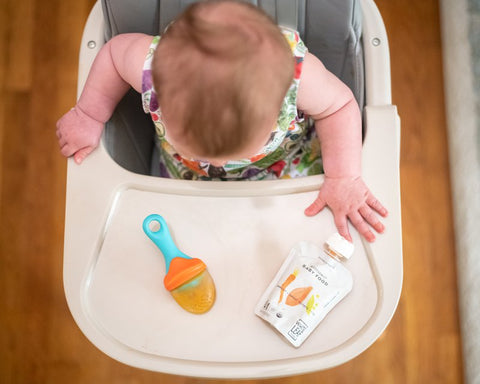Babies’ Taste Buds -- What Parents Need to Know
There seems to be a certain mystery surrounding babies’ taste buds. From the notion that all baby foods should be bland, to believing that artificially sweetening dishes will get your baby to eat more, or the use of misleading terms like “developing your baby’s taste buds” and “palate training” -- it can all sound a bit confusing.
So what is the deal with our babies’ taste buds?
Your baby’s sense of taste starts developing in the uterus. Babies’ taste buds develop in early pregnancy along with their mouth and tongue, and they are able to taste the amniotic fluid, which changes in flavor depending on what you ate. Later on, if you are nursing, your baby will experience flavors of what you ate through the breast milk. Babies’ taste buds are very sensitive at birth, and as infants they can distinguish between sweet, sour and bitter tastes.
Intuitively, babies prefer sweet foods, like their mother’s milk, which is essential for their survival. In nature, sweet foods are generally healthy and nutritious, full of vitamins and carbohydrates. The same is not true for “empty calorie” sweeteners like sugar or corn syrup for example, which provide little nutritional value and should be avoided, so that your child will not develop a preference for overly sweet foods.
Most babies initially reject bitter flavors, which is also an intuitive reaction: if found in nature, a bitter taste could indicate poisonous or spoiled foods. However, a liking of bitter flavors can be learned, and some bitter foods such as cabbage and artichoke can offer great nutritional value.

Avoiding Salt & Sugar
Babies do not develop the ability to taste salt until they are about 5 months old. A salty flavor would normally indicate a food that is high in minerals and therefore it would be beneficial for a baby to like it, but it is not a good idea to add salt to your baby’s food at this age. With the abundance of processed and overly salty foods available to us on a daily basis, American children consume on average about twice the recommended amount of sodium per day, which has been associated with health risks like high blood pressure and heart disease.
Not adding any salt or sugar to your baby’s foods does not mean that their meals have to be bland! If you look at other cultures, children often enjoy a variety of flavors from an early age. Babies’ taste buds are very sensitive and they also possess a well-developed sense of smell, which is linked to the sense of taste. When eating, the taste buds on the tongue register the taste of food, the olfactory sensors in the nose register the smell, and the sensory receptors register the texture – all of which combines into a single complex flavor experience for us.
You can get creative using fragrant herbs and mild spices and watch your child’s reaction upon exploring those new tastes. Be careful with very spicy foods as they can be irritating to a baby’s skin, tummy or butt.
Discovering Your Baby’s Taste Preference
Even though most babies tend to like the flavors they were exposed to in the womb and later through breast milk, they will develop taste preferences of their own once they start eating solid foods. Giving your baby a variety of different foods, flavors and textures to try can help to make them more open to trying different foods as they get older.
Offer new foods without pressure or bribery when both you and your child are in a good mood. Do not be discouraged if your child initially rejects something. Children need to try a new food 10 or more times to develop a liking for it and accept it as part of their regular diet. This, too, is an innate and normal behavior.
You can also offer new foods, along with a tried-and-tested favorite. That way you can encourage your child to have a taste, mix dishes together to blend the flavors, and still have the backup option to let them fill up on their favorite if the introduction of the new food ends up unsuccessful.

Developing your child’s palate involves more than just the taste buds, though!
Let your child play with their food to explore it with all their senses. Let older children help in the kitchen to cook or prepare foods, and present the dishes in a fun or colorful way. Depending on your options, take them grocery shopping with you, teach them how to plant vegetables or grow an herb garden on your windowsill. Read books about farming or even go visit a farm to let them see where their food comes from. Children learn from the behavior that their parents, caregivers and siblings model. If you want them to follow a healthy diet, be sure you set a good example.
Most of all, don’t stress and try to make eating as much of a social and fun experience for you and your family as you can. Growing up in Germany, we had a saying that if you don’t finish everything on your plate, it will result in bad weather the following day. Don’t ask me where this theory came from! My guess is that in times of war and food shortage you could just not afford to waste anything. But this type (or worse) of authoritative feeding is no longer encouraged today, because it can cause anxiety around mealtimes and prevents children from developing natural responses to their hunger and satiety cues.
Remember your child’s diet does not have to be perfect every day (and neither does yours!) but achieving a balanced diet over the course of a week is a more realistic goal. And while there are certain ages when it is easier to develop your child’s liking for healthy foods and establish good eating habits, it is never too late to start trying!
*Disclaimer: this article is for informative purposes only and not to be seen as medical advice. Always offer food to children in a way that is safe and appropriate for their age and eating skills. If you have any concerns about your child’s health, their diet or development, please contact your pediatrician!*
